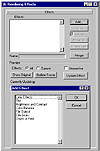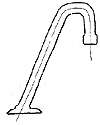| |
| |
Mastering
3D Studio MAX R3 |
Choosing
Lens Effect Settings
Lens Effects provide the ability to add optical effects such as lens
flares, solar coronas, and object glows to your scenes. Lens Effects offer
so many options, a whole book could be written on them alone. Table 11.5
describes the appearance of some of the lens effects options.
Table 11.5: LENS EFFECTS
AND THEIR USES
| Lens Effect
| Visual Appearance
|
| Glow
| Glow around light, or based on other selections
described in Table 11.6
|
| Ring
| Ring offset from glow
|
| Ray
| Small criss-crossed streaks
|
| Auto Secondary
| Colored circles (or shapes) between camera
and effect object to simulate lens flares of real cameras
|
| Manual Secondary
| Another lens flare effect that can be
added to auto-secondary flares; manual options for creating unique
flare
|
| Star
| Very controlled star shape from center
of effect
|
| Streak
| Single linear optical effect
|
On the Options tab for Lens Effects is an Image Sources section. This
selects which parts of the image will be altered by the effect. Table
11.6 describes the different source settings and how these select the
pixels to be affected.

Table 11.6: IMAGE SOURCE
SETTINGS
| Image Source
| Selection in Image
|
| Object ID
| Any pixels corresponding to an object
with that ID in the image (Object ID is set in Object Properties)
|
| Effects ID
| Any pixels corresponding to a material
with that Material Effects ID in the scene (Material Effects ID is
set in the Material Editor)
|
| Unclamped
| Any pixels with values above pure white
(RGB 255, 255, 255)—bright areas and highlights.
|
| Surf. Norm
| Pixels corresponding to face normals whose
angle from the camera is within a set value
|
| Whole
| The entire image
|
| Alpha
| The image’s alpha channel
|
| Z-Hi/Z-Lo
| Pixels corresponding to objects selected
by their distance from the camera
|
Applying
Render Effects Interactively
A tremendously powerful feature of the Render Effects dialog is its new
interactive rendering of Render Effects. When you check Interactive, the
renderer will open a Virtual Frame Buffer to view the result of the applied
Render Effect. It will then re-render just the post-process pass in the
VFB as you change the parameters of the effect. You can also move a source
object like a light and click the Update Scene button to update the VFB.
This saves an enormous amount of time rendering in order to see the effect
of your settings.
Hands-on MAX: A Complete
Faucet Animation
Now that we have covered skills of modeling, animation, materials, lighting,
and rendering, let’s complete an exercise incorporating all of these
tasks.
Suppose a client has hired your team to create an animation segment of
a bathroom sink. They want the water tap to turn on and off and a burst
of water to bulge from the faucet as it moves toward the spout (very unrealistic
but fun!). The burst of water is to come flying out of the faucet opening
and splash into and out from the sink. Your job is to first to build the
faucet with its bulging water effect, water burst, and materials; then
to incorporate this animation into the rest of the scene created by your
team; to cause the water to deflect off the sink; and finally to fine-tune
and render the complete animation.
In this exercise you will:
- • Create and edit spline shapes
- • Create and edit a faucet using Loft
- • Use the Displace space warp to distort the
faucet
- • Create water using Super Spray metaparticles
- • Assign and modify existing materials
- • Merge 3D Studio MAX files
- • Adjust animations in the Track View
- • Use the UOmniFlect space warp to deflect
the water from the sink
- • Render the animation
|
|
|

| NOTE The finished
file waterburst.avi is included on the CD if you would
like to see the desired result.
|
Preparing
the Faucet Loft Path
Let’s begin by creating the shapes that will make up the faucet
loft object.
- 1. Open file faucet_1.max from the
CD. This file is has been set up for you with the following parameters:
units are set to Feet w/Fractional inches of 1/8; the grid displays
lines at 1 inch intervals, with major lines every twelfth line; and
the viewports have been adjusted to display an area of about one square
foot.
- 2. The designer has provided us with a hand-drawn
sketch. The scanned file is shown in Figure 11.18. Choose View File
under the File menu and double-click faucet_template.tif
on the CD. We will create a path similar to the centerline shown on
the sketch, create the shapes that will be lofted along this path, and
then adjust the loft to create the finished faucet. Close the image
file

FIGURE
11.18 Sketch of the faucet
- 3. Click the Line button (Create Ø
Shapes Ø Line). We are going to
start the path at the base of the faucet at the World 0,0,0, extending
it 9 inches high and 6 inches over the sink.
- 4. Open the Keyboard Entry rollout in the Create
tab. With 0,0,0 as the X, Y, and Z values, click the Add Point button.
Enter an X value of 3" and a Y value of 9" and click Add Point again.
Enter an X value of 6" and a Y value of 9" and click Add Point again.
Enter an X value of 6" and a Y value of 5" and click Add Point again.
Click the Finish button to complete your line.

|
|
|

| WARNING Be sure
to enter the ” character or MAX will default to feet.
|
|
|
|

| TIP This keyboard
entry method is useful for precision work. You could also create the
approximate shape and move the vertices using the Transform Type-In.
|
- 5. Under the Name and Color rollout, rename this
spline from Line01 to path_faucet.
- 6. Right-click anywhere in the viewport to get out
of the Line tool. Right-click your spline and select Modify Mode from
the shortcut menu to take you to the Modify tab.
- 7. Right-click the spline again and this time choose
Sub-Object Ø Vertex from the shortcut
menu.
- 8. In the left viewport select the two topmost vertices
of the spline, enter 1.25" in the Fillet field in the Geometry rollout,
and press Enter. Your spline should now look like Figure 11.19.
- 9. Right-click the spline and choose Sub-Object
Ø Base Object from the shortcut
menu to exit Sub-Object mode.
© 2000, Frol (selection,
edition, publication)
|
|




